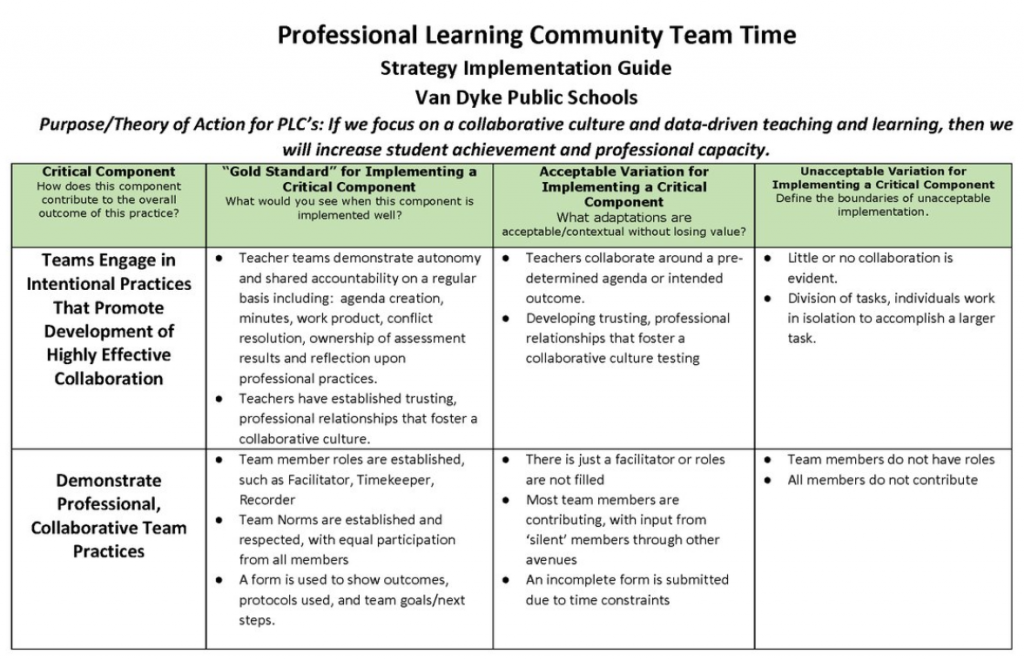This is part 3 in a series on coaching collaborative teams in professional learning communities. To view all posts see Coaching in a PLC at Work™.
“To begin with the end in mind means to start with a clear understanding of your destination. It means to know where you’re going so that you better understand where you are now so that the steps you take are always in the right direction.” ―Steven Covey
Schools and districts with professional learning community (PLC) implementation understand the importance of Covey’s words. Knowing one’s destination is foundational to ensure movement, and actualizing results is the responsibility of the collective group. Knowing the steps that channel a collaborative team in the “right direction” is often a challenge. However, these steps can be clarified by creating a strategy implementation guide.
In our book, Amplify Your Impact, Coaching Collaborative Teams in PLCs, my coauthors and I advocate that coaching collaborative teams is a vital component to owning successful PLC implementation. Coaching collaborative teams—centered on the cornerstones of clarity, feedback, and support—is a long-term investment in the collaborative practice. While coaching teams advances PLC ownership, we need to ask ourselves, “What success criteria are we basing our coaching on?”
The Strategy Implementation Guide (SIG)
A strategy implementation guide (SIG) is a main driver in the collaborative team coaching process. Coaches use it as a reference point to support teams to higher levels of effectiveness. It also provides clarity and serves as a PLC implementation road map to schools.
A foundation of a SIG is based on the following five essential prerequisite conditions of establishing a PLC (DuFour 2015). These conditions are “tight” and must be in place in order to have a high-functioning professional learning community.
- Educators work in collaborative teams and take collective responsibilities for student learning, rather than working in isolation.
- Collaborative teams implement a guaranteed and viable curriculum, unit by unit.
- Collaborative teams monitor student learning through an ongoing assessment process that includes frequent, team-developed common formative assessments.
- Educators use the results of common assessments to improve individual practice, build the team’s capacity to achieve its goals, and intervene and enrich on behalf of students.
Creating = Ownership
The advantage of developing a strategy implementation guide is realized when all stakeholders in a school coauthor it. Great principals and instructional coaches know fostering PLC ownership can only be done through inclusionary practice. Cocreation of a SIG takes time. However, creating it together results in developing shared knowledge, building common vocabulary, and alignment to common outcomes. These have powerful impacts on a school culture.
Sample Strategy Implementation Guide
Drawing Parallels
When teams understand the process to unwrap essential priority standards and can break them into a progression of measurable learning targets that scaffold toward mastery, then they are well on their way to understanding the process to develop a SIG. Teams realize prioritizing is more than just developing a list of standards and targets. The value is in the conversation and to learn from one another.
| Unwrapping Priority Standards | Strategy Implementation Guide |
Priority Standards
|
Anchor Statements (left-hand column)
|
Learning Targets
|
Descriptors (bulleted progressions)
|
When a staff commits to coauthoring a SIG, they engage in a similar process to when teams unwrap priority standards. They:
- Examine the five essential prerequisites of establishing a PLC (in effect, these prerequisites are the PLC process priority standards).
- Reach agreement and define the five conditions in context of their school.
- Craft anchor statements associated with each of the five prerequisite conditions.
- Deconstruct each anchor statement into a progression of descriptors that increase in complexity. The descriptors detail the adult actions and behaviors associated with each anchor.
Through this process, schools are able to collectively define long-term outcomes and short-term benchmarks that align to practices associated with becoming a high-functioning PLC.
Common Benefits and Outcomes
Whether a school is unwrapping priority standards to clarify what a student must master or developing a SIG to build clarity on highly effective collaborative practice in a PLC, the outcomes and benefits are the same. Both processes take into account the individual understanding of stakeholders and result in development of a unified set of outcomes and priorities.
Both processes develop shared knowledge, build common vocabulary, and generate agreed-upon standards of best practice. One meets the needs of students and their learning, and the other is essential for collaborative team practice.
At Secrest Elementary, Jeffco Public Schools, Colorado, teachers and school leadership have remained committed to PLC implementation. Secrest’s instructional coach, Julia Ridell, reflected, “Our SIG has provided a whole new level of focus for me and the teams I coach. It has fundamentally shifted my role and how I support teams. We have newfound clarity and direction. It’s exciting. I am seeing teams increase their effectiveness on a consistent basis!”
Secrest Elementary, like many others nationwide, stands as an example of a school that intentionally sought clarity through the use of a SIG and bolstered coaching support to move PLC implementation in the right direction for student learning.
Michael Maffoni has more than 30 years of public school experience as a teacher, principal, and district administrator. He is currently the director of PLCs in Jefferson County Public Schools in Colorado, affiliate faculty in the Educational Leadership Program at Regis University, and coauthor of Amplify Your Impact: Coaching Collaborative Teams in a PLC at Work.
Follow Michael J. Maffoni on Twitter @mjmaffoni64.
References:
DuFour, R. (2015, May 8). In praise of American educators: And how they can become even better. Speech presented at the Summit on Professional Learning Communities at Work, Phoenix, AZ.
[author_bio id=”1616″]








